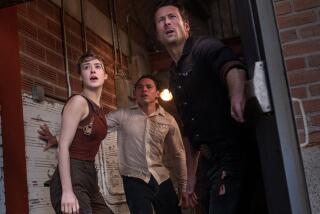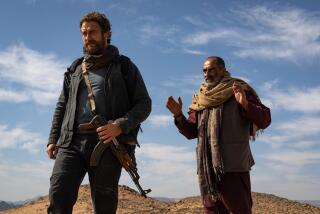Local Boy Makes Good . . . in Bollywood
- Share via
What’s a guy who grew up in the Fairfax District doing in the middle of the Indian film industry?
That’s what lots of people ask Mark Burton, an American producer of the Indian film “The Terrorist” and a veteran of “Bollywood,” the enormous, Bombay-based film industry that churns out extravagant formulaic melodramas.
“My friends would ask me, ‘What is this crazy life you have?’ ” says Burton, a USC theater alum. “I went to Fairfax High School. We never learned about India’s history or culture. It’s a fascinating place. I fell in love with the country and the people.”
“The Terrorist,” in the Indian language of Tamil with English subtitles, is a small art-house film, a big step outside Bollywood for Burton. Shot in 16 days for about $50,000 with nonprofessional actors, “The Terrorist” is the directorial debut of Santosh Sivan, one of India’s leading cinematographers and a friend of Burton’s from another movie they did together. Opening today for a one-week run at the Nuart in West Los Angeles, “The Terrorist” follows a 19-year-old woman living in a South Indian guerrilla camp who volunteers for a suicide mission.
The film is not a true story and political specifics are kept vague, but Sivan, also the movie’s co-writer and cinematographer, says he was inspired by events surrounding the 1991 assassination of Indian Prime Minister Rajiv Gandhi.
Burton and Sivan met on a Bollywood location shoot in Utah, of all places, and the two agreed on Sivan’s idea for “The Terrorist,” a project that allowed Sivan to move into directing and Burton a chance to break out of Bollywood and make a film geared toward Western audiences.
Though the title suggests screen mayhem, most of the violence in “The Terrorist” occurs off camera. On the phone from Bombay, Sivan says, “I wanted to make a film where the audience comes in thinking they are going to see a lot of violence and then they begin to feel, ‘No, I don’t want there to be violence.’ I didn’t want to glorify it. What kind of person would give up their life like that? Maybe there are things she could see and feel that would make her stop.”
Constant TV coverage of the 1991 Gulf War also got Sivan thinking about appetites for violence. “There were people sitting in front of the television waiting for something bad to happen on the screen, and they were disappointed if nothing happened that day,” he says. “It was like a game.”
To help make ends meet on “The Terrorist’s” slender budget, the film lab in India where Sivan gets his other movies processed provided some services at no charge. Independent investors in New York chipped in. And Sivan recruited film students and other industry novices for a one-week movie boot camp of sorts in his Madras backyard. “The people who could figure out the equipment became the crew, and those who couldn’t became the actors,” Burton says.
“With the exception of the lead actress [Ayesha Dharkar], it was everyone’s first time on a film,” Sivan says. “It was everyone helping everyone, a labor of love.”
Gregarious and talkative, Burton, 36, works from an office in a Hollywood house, trying to create a buzz for “The Terrorist.” He’s also representing the movie at this week’s annual American Film Market in Santa Monica, where foreign entertainment executives buy films for their theaters, TV channels and video stores.
“It’s a psychological thriller, artfully told,” Burton says of “The Terrorist,” the fifth Indian film he has helped produce. The first four were strictly Bollywood: violent action, melodramatic romance, slapstick comedy and extravagant musical numbers.
Some might say Burton’s path to Bollywood and back is a movie in itself.
The Circuitous Route to Where He Is Now
While living in London after college, Burton met an Indian rock ‘n’ roll promoter who had extra time on his hands--monsoons in India four months each year prevented outdoor concerts. But the show must go on, so the two partnered to export something else to India--Broadway and British plays and some musical revues. They sent American and English performers on the road throughout India, where about 250 million of that country’s more than 800 million people speak English.
Travels as a theater promoter led to contacts with Indian film producers, and one needed help on location sequences he planned to shoot in the U.S. “Here I was doing these crazy plays,” Burton says of his life when Bollywood came knocking. Bollywood is “totally chaotic and wonderful, and it’s amazing anything gets done but it does. It’s a huge, burgeoning business.”
Escapist fantasy is a Bollywood staple and characters often take magical journeys, so unusual landscapes and locations outside India are desirable. Burton usually produced the U.S. location shoots.
“We shot in Beverly Hills, Las Vegas and the desert,” says Burton of his first project, when with more enthusiasm than experience he supervised 40 Indian crew members. Other U.S. locations on Burton’s later Bollywood movies included a Palmdale windmill farm, where in the climactic scene the hero beats the villain and rescues the girl at the base of a 30-foot statue of a goddess the filmmakers made and plopped in among the windmills.
Bollywood movies “are all pretty much the same,” Burton explains. “Some have more action, others more romance, but most have these elements: Boy from wrong side of the tracks falls for girl from right side of the tracks. Her father doesn’t approve, so the boy has to prove his heroism to her family. Through that heroism there’s lots of action and some broad Three Stooges-type comedy.
“But most of all, there’s the songs, 10 to 12 music video-style songs in the movie. They’re extravagant--like 1930s Busby Berkeley. They play on TV before release, so when the movie comes out, everyone knows the songs and they sing them in the movie theater. It’s a crazy, wild scene. But they’re subtext to the movie.
“For example, we’re talking now. If this was an Indian movie, we’d suddenly break into song.”
‘The Movie Has to Be a Feast’
To see a movie in India costs anywhere from 75 cents to $5, and it had better be three hours long or “they feel they’ve been ripped off,” Burton says. “The movie has to be a feast.”
Burton doesn’t believe “The Terrorist’s” 95-minute length hurt its popularity in India. “It’s such a different animal,” Burton says of the comparison to Bollywood fare. “These more serious films traditionally haven’t been taken seriously by the masses, but it’s changing. It’s like comparing ‘Titanic’ to ‘Limbo.’ ”
Within India, the movie’s popularity was boosted by dubbing it into Hindi, the country’s most widely spoken language, and broadcasting it on TV. Abroad, it was well received at Sundance, Toronto and other festivals, and took the top prize at the 1998 Cairo Film Festival. John Malkovich, who presided over the festival jury in Cairo, loved the movie and worked beyond the festival to help raise awareness for the film. Phaedra Cinema signed on as U.S. distributor.
Finding a distributor was tough for Burton. “Their misconception seemed to be, if a movie is about a quaint, charming Italian village with cobblestones and eccentric villagers, then Western audiences can relate to that. That isn’t our movie. Some people incorrectly think audiences won’t relate to characters from a culture foreign to them.
“Having had these wild experiences, I’m definitely moving toward more Western-style narrative movies,” Burton says. “You taste another culture and it gives you insight, and you come back and hopefully attack things in a new way that’s a little exotic or spicy or different. You never know where your path is going to lead.”
More to Read
Only good movies
Get the Indie Focus newsletter, Mark Olsen's weekly guide to the world of cinema.
You may occasionally receive promotional content from the Los Angeles Times.










